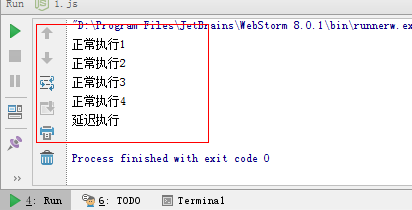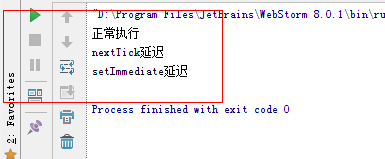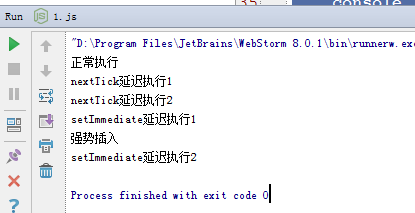1.node中使用定时器的问题在于,它并非精确的.譬如settimeout()设定一个任务在10ms后执行,但是在9ms后,有一个任务占用了5ms,再次轮到定时器时,已经耽误了4ms.
好了node中的定时器就简单的讲这么多.
2.看代码:

通过这个例子,我想大家很清楚的就能看到nextTick()是用来干嘛的了.主要是用来异步执行的.
在看代码:

我们发现setImmediate也是异步执行的.奇怪了
那么它与nextTick()有什么区别呢?
看代码:
代码一:
结果:

代码二:
结果:

发现代码虽然顺序不一样,但是执行的结果是一样的.
从结果可以发现:
nextTick()的回调函数执行的优先级要高于setImmediate();
process.nextTick()属于idle观察者,setImmediate()属于check观察者.在每一轮循环检查中,idle观察者先于I/O观察者,I/O观察者先于check观察者.
在具体实现上,process.nextTick()的回调函数保存在一个数组中,
setImmediate()的结果则是保存在链表中.
在行为上,process.nextTick()在每轮循环中会将数组中的回调函数全部执行完.
而setImmediate()在每轮循环中执行链表中的一个回调函数.

从执行结果上看出:当第一个setImmediate()的回调函数执行完后,并没有立即执行第二个,而是进入了下一轮循环,再次按nextTick()优先,setImmediate()次后的顺序执行.之所以这样设计,是为了保证每次循环能够较快的执行结束.防止CPU占用过多而阻塞后续I/O调用的情况.
以上就是相关node.js中的定时器nextTick()和setImmediate()区别的资料了,小伙伴们是否清楚了他们之间的区别了呢?

每个人都需要一台速度更快、更稳定的 PC。随着时间的推移,垃圾文件、旧注册表数据和不必要的后台进程会占用资源并降低性能。幸运的是,许多工具可以让 Windows 保持平稳运行。

Copyright 2014-2025 https://www.php.cn/ All Rights Reserved | php.cn | 湘ICP备2023035733号